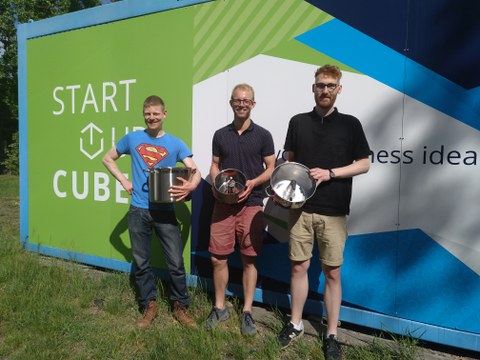May 23, 2019
Stress-free cooking -TU founding team invents self-stirring cooking pot

From left to right: Axel Fickert, Michael Stampka und Paul Frölich
There are currently over 14 million induction stoves in Germany, which are used daily in private households as well as in gastronomy, and the trend is rising. Induction stoves enable fast, precise cooking and can reach very high temperatures within a few seconds. However, the high performance also has decisive disadvantages: If the heating level is too high and the movement of the food is too low, the risk of the food sticking, burning and boiling over increases. The cooking vessel must therefore be permanently monitored and stirred, which is usually done manually and prevents the cook from carrying out other activities during this time. Here Quirl'it, a spin-off of the TU Dresden, supervised by Prof. Dr.-Ing. Steffen Ihlenfeldt (holder of the professorship for machine tool development and adaptive controls), would like to find a remedy in the future with its self-stirring cooking pot.
The three young researchers Axel Fickert, Michael Stampka and Paul Frölich have known each other since their student days and developed a model in 2018 that will make manual stirring superfluous in the future. The idea came to Axel Fickert while cooking, when something burned himself and he was looking for a solution to avoid having to stand permanently on the stove: "In the beginning, I temporarily attached a stirrer to the cooker hood. Then I had the idea of using the energy generated by the magnetic fields of induction cookers to make a self-stirring cooking pot." After numerous experiments and many destroyed cooking pots, a first approach to solving the problem was found and Axel Fickert applied for a patent in 2017. In cooperation with Tridelta Weichferrite GmbH in Hermsdorf and supported by Michael Stampka's father's electrical installation company, various soft ferrites for the construction of an energy conversion unit for use in cookware have been tested for their suitability since the beginning of 2016 and several functional models have been built. These consist of a cooking vessel with integrated energy conversion unit (EWE) and an agitator module (RWM) with high-frequency rectifier and gear motor, which drives a removable agitator arm via a drive shaft.
A self-stirring cooking pot without an external power source and with intuitive operation, this is the aim of the 3-member founding team. "Our first target group is the catering trade, since larger quantities are simply cooked here and we can therefore build our appliance larger; this saves costs," says Paul Frölich. Gastronomes in and around Dresden were already asked and showed high interest in the invention, which would mean a large saving of time. The vision for the next two years: sensors for temperature monitoring, loudspeakers and LEDs to give the cook feedback. The integration of a Bluetooth connection is also conceivable in order to be able to control the pot via the mobile phone. With the integration of smart home technology, the inventors also want to inspire private customers for the pot. A first prototype series is currently being produced, which will also be tested by restaurateurs in order to obtain initial feedback and to adapt and optimise the invention to demand. Touch or gesture operation will also be added at a later date to make the pot as user-friendly and time-saving as possible. The founding team is looking for a partnership with cookware manufacturers who want to integrate their innovative technology into their products.
